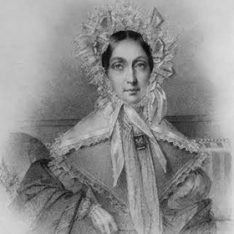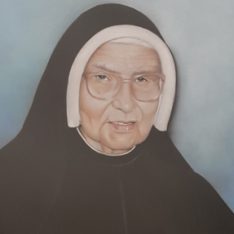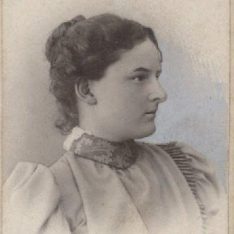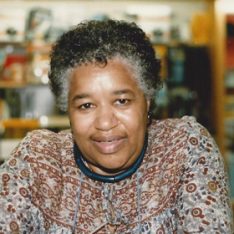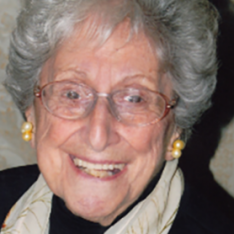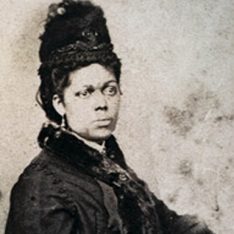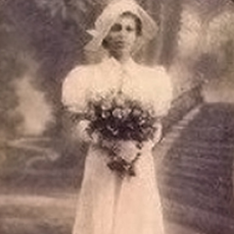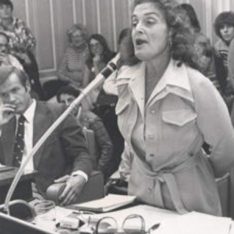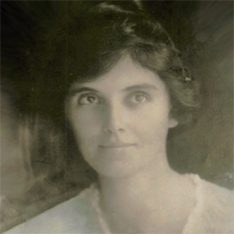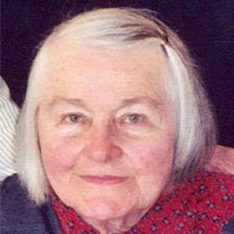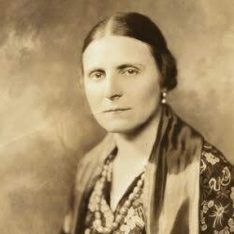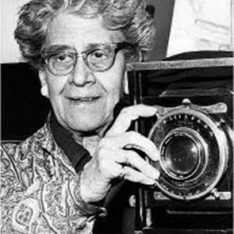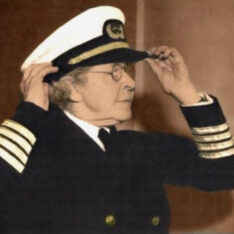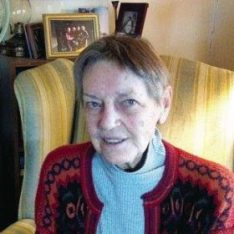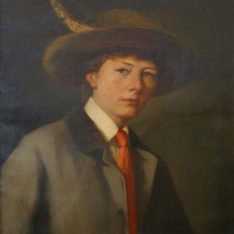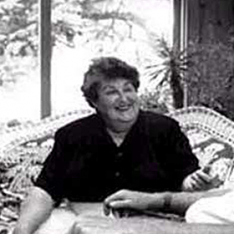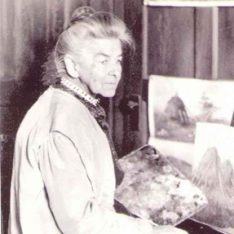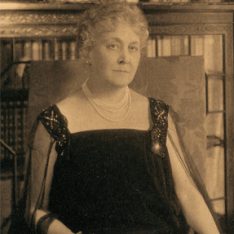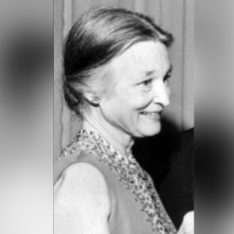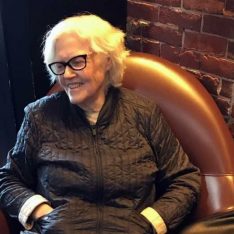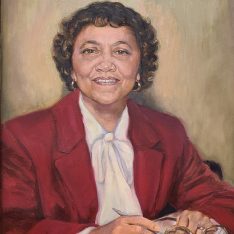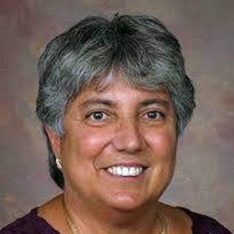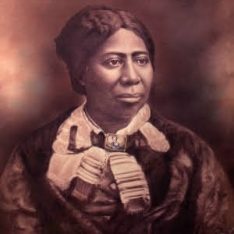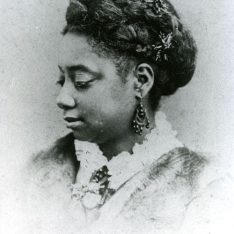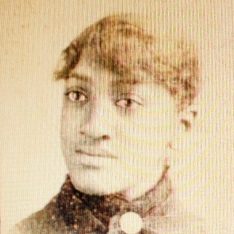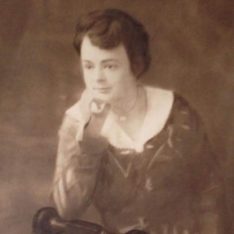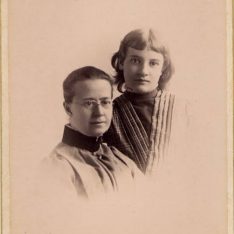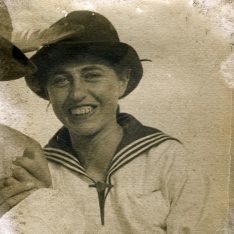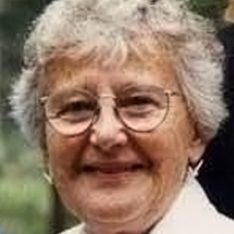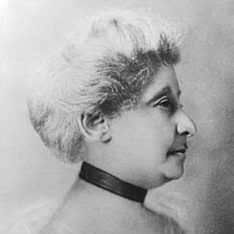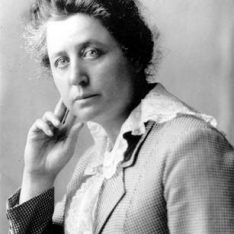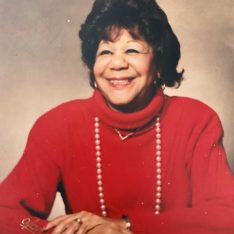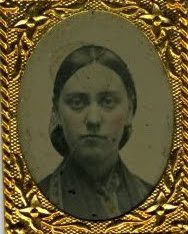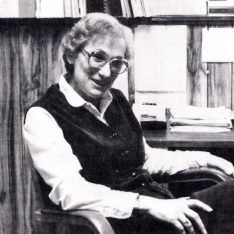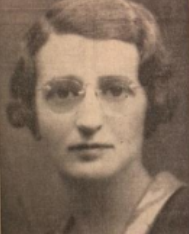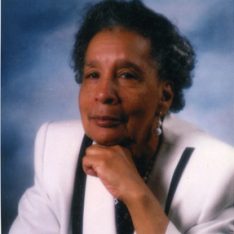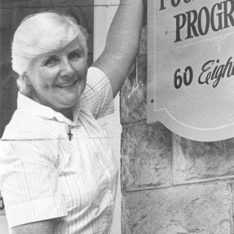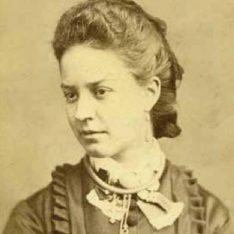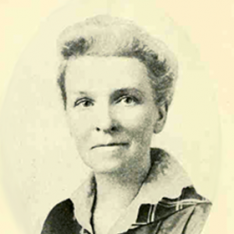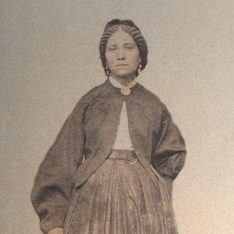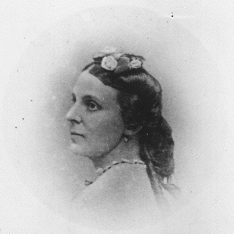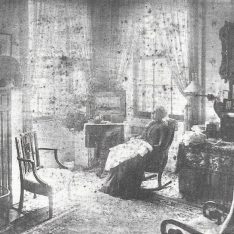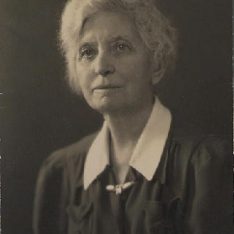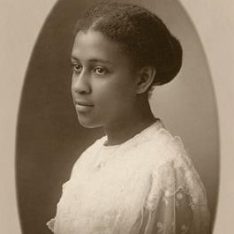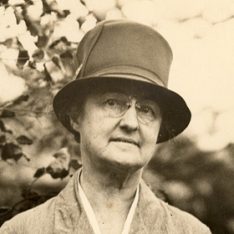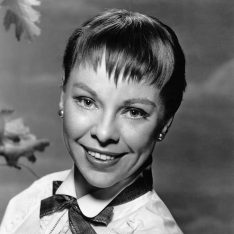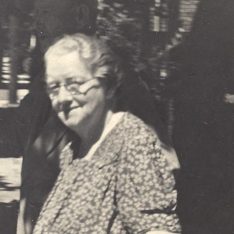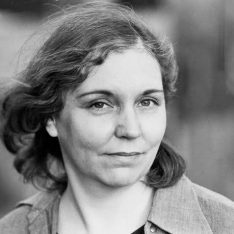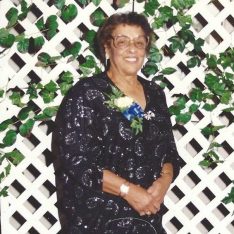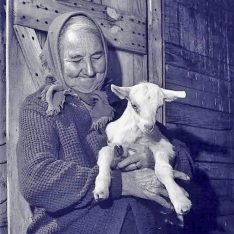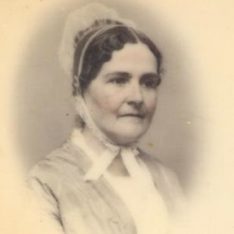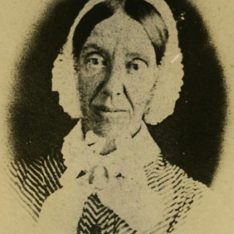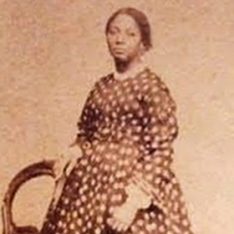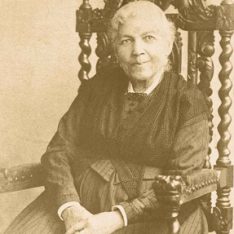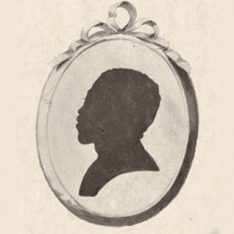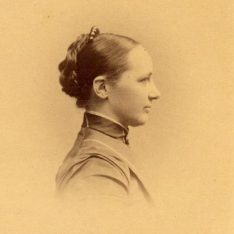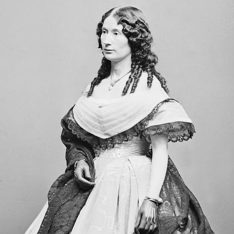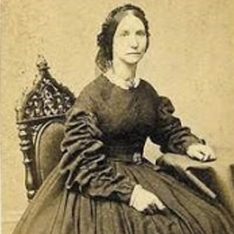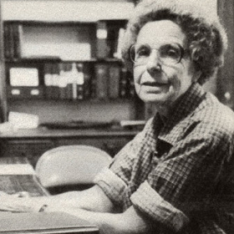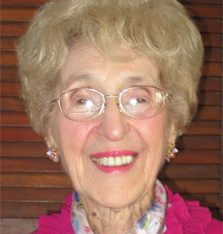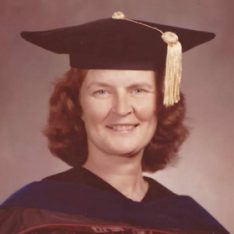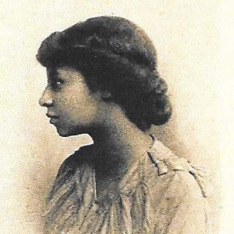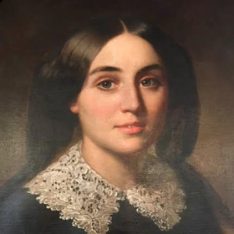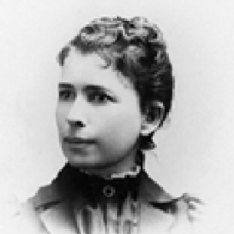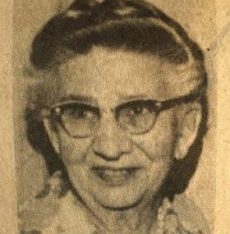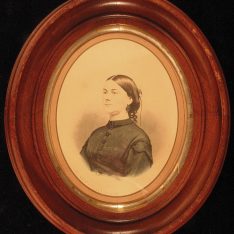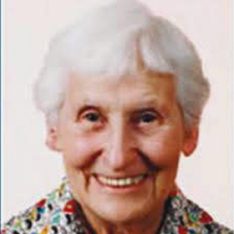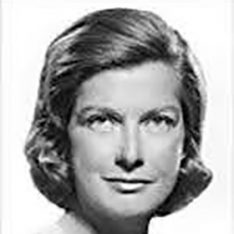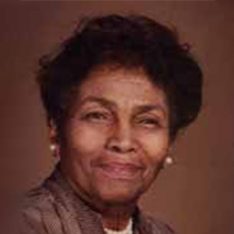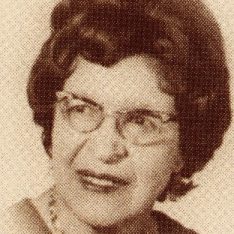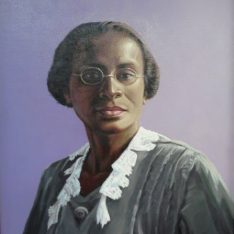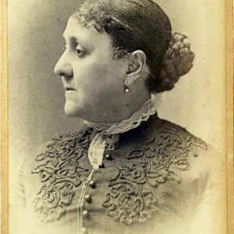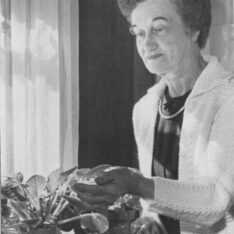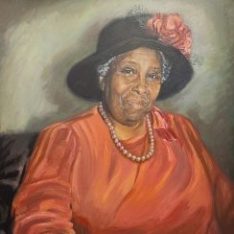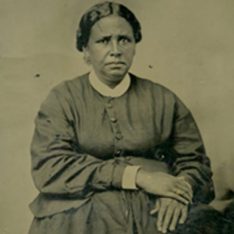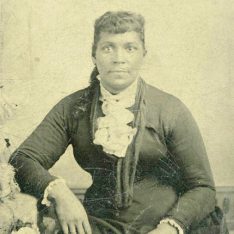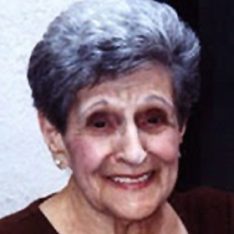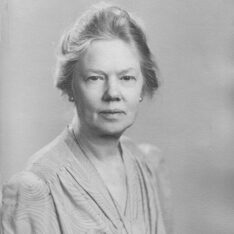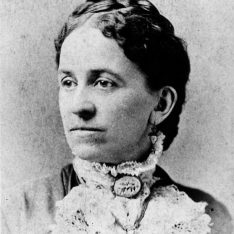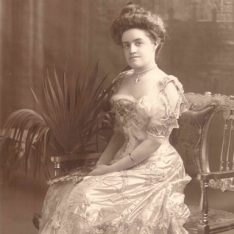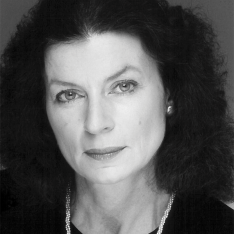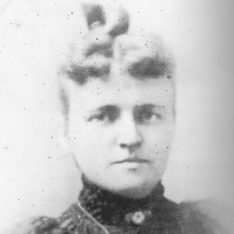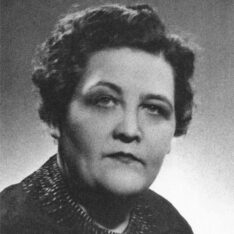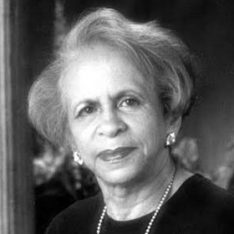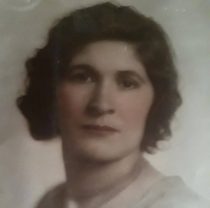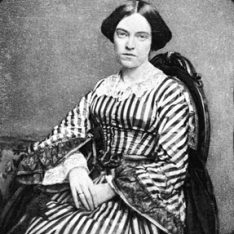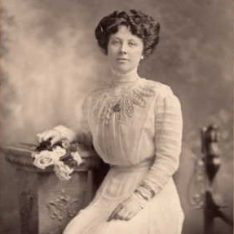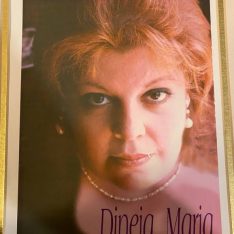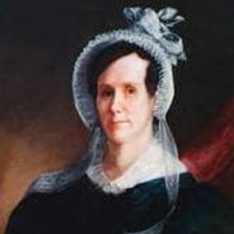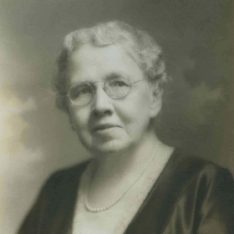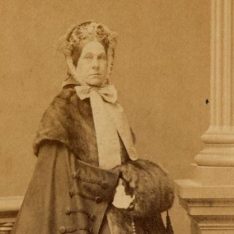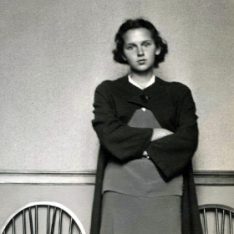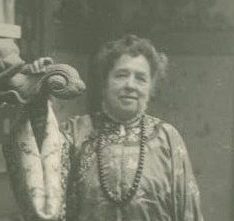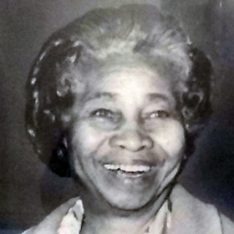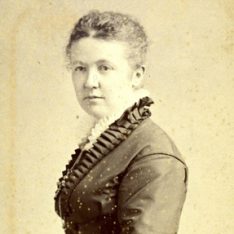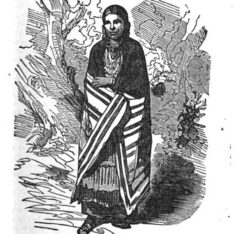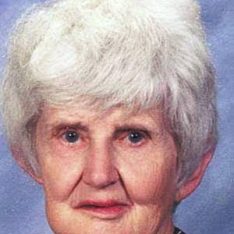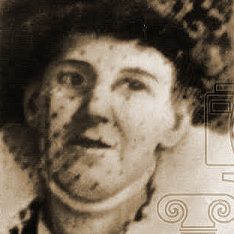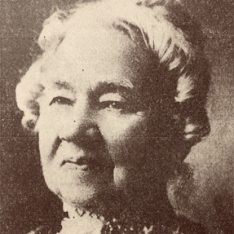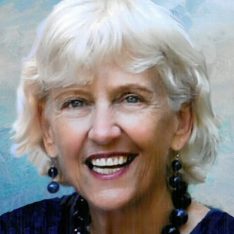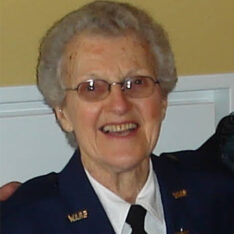PROFILES – BY LOCATION
- All
- Acushnet
- Dartmouth
- Fairhaven
- Fall River
- Marion
- Mattapoisett
- New Bedford
- Rhode Island
- Rochester
- Wareham
- Westport
Maria Alves
Feelings of “saudade,” love, loss and longing, were created when Maria Fernandes Alves (1924-2008) sang fado, traditional Portuguese folk music, throughout the South Coast and beyond.
Laurinda C. Andrade
From immigrant textile mill worker to Ivy League student to pioneering New Bedford educator, Laurinda C. Andrade (1899-1980) overcame barriers of tradition, poverty, language, and discrimination to establish the first high school Portuguese language department in the United States at New Bedford High School.
Sarah Rotch Arnold
Nineteenth-century New Bedford’s Sarah Rotch Arnold (1786-1860) was dedicated to her community, social reform, religious tolerance, and horticultural beauty.
Hope Atkinson
Devoted to sailing and public service, Hope Atkinson (1927-2015) made a difference across the South Coast region.
Ruth S. Atkinson
Devoted to sailing and the arts, Ruth Showalter Atkinson (1920-2013) appreciated the beauty of the South Coast.
Sister Aurora Helena Avelar
New Bedford’s Mother Teresa, Sister Aurora Helena Avelar (1903-1999) was a Roman Catholic nun who devoted her life to the underserved.
Awashonks
Awashonks was a Native American woman who served as a chief of the Sakonnet (variations include Sogkonate, Seconit, Seaconnet, etc.) people in what is today Little Compton, Rhode Island before, during, and after King Philip’s War (1675-1676). The name Awashonks appears in official records more than the name of any other Native American woman.
Mercy Etta Baker
Westport artist and author Mercy Etta Baker (1876-1957) focused on the Westport landscape, its dunes and natural beauty, in her paintings.
Mary Santos Barros
A New Bedford City Councilor who represented Ward 4 for two terms, Mary Santos Barros (1923-2018) was a strong advocate for all, most notably Cape Verdeans. Recognizing that diversity is our strength, Mary taught us that we can build an inclusive community that treats all people with respect and dignity.
Dora Bastarache
A stitcher in various New Bedford shops, Dora Bastarache (1915-1988) was a true rank-and-file leader in the International Ladies’ Garment Workers’ Union in southeastern Massachusetts, where she served as president of that union’s Local 361.
Loretta Bourque
A dedicated activist who advocated for New Bedford’s neighborhoods, Loretta Bourque (1920-2018) was referred to as “Mayor of the South End” for her special commitment to this section of the city. Through the Cove Street Neighborhood Association, Loretta led efforts against such problems as negligent absentee landlords, crime and drugs. Loretta’s influence was a key factor that led the New Bedford City Council to pass the city’s Problem Properties Ordinance.
Emily Howland Bourne
Emily Howland Bourne (1835-1922) showed the same careful planning in her inspired philanthropy as her father Jonathan showed as one of New Bedford’s most successful whaling merchants.
Martha Bailey Briggs
Born in 1838 to Black abolitionists, Martha Bailey Briggs (1838-1889) realized at a young age that education was essential to ending slavery.
Lena Britto
Born and raised in Rochester, entrepreneur and activist Lena Britto (1921-2007) owned and operated Van-Lee Beauty Salon in East Wareham for over 18 years.
Rosalind Poll Brooker
Rosalind Poll Brooker (1928-2016) was a trailblazer for women in the fields of law and politics.
Lydia Grinnell Brown
New Bedford’s Lydia Grinnell Brown (1892-1945) became the first African American graduate of Simmons College in Boston.
Alberta Simmons Brownell
Alberta Simmons Brownell (1882-1918) used book knowledge and personal experience to write articles on the social problems of the day.
Mary Ricketson Bullard
Accomplished historian and author Mary Ricketson Bullard (1926-2014) wrote scholarly articles, books and even a libretto as part of an opera based on the life of Elizabeth “Zabette” Bernardey, the biracial common law wife of Cumberland Island, Georgia plantation owner Robert Stafford.
Maria (Maja) Capek
Unitarian church leader Maja Capek (1888-1966) served New Bedford’s North Unitarian Church, where daughters of immigrant mill workers from Central Europe could meet for games and classes in sewing, millinery, and cooking.
Theodosia Chase
Photographer and artist Theodosia Chase (1875-1972) was a librarian at the old stone Southworth Library in Padanaram, where she sold her photo postcards of residences, children and animals.
Bertha Cohen
Bertha Alpert Cohen (1898-1974), also known as Mrs. A. J. Cohen, or Bessie Alpert, was a lifetime resident of New Bedford and member of Tifereth Israel Synagogue.
Pauline Meyer Colyar
Landscape painter Pauline Meyer Colyar (1873-1928) was admitted to the Art Academy of Cincinnati at the age of 13, the youngest age for admission.
Shirley Bernice Cohen
A librarian at the New Bedford Free Public Library, Shirley Bernice Cohen (1924-2000) dedicated her life to helping her community through charity work with the New Bedford Junior Hadassah
Mary Parker Converse
At age 68, Mary Parker Converse (1872-1961) was sworn in as a full Captain in the U.S. Merchant Marine, the first woman to hold an Unlimited Tonnage Masters License, in 1940.
Tryne Costa
New Bedford social worker Tryne G. Costa (1922-2018) lived by a poem that she learned as a young girl, “Let me live in my house by the side of the road / And be a friend to man.”
Cecil Clark Davis
Her portraits won prestigious awards, her travels included battlegrounds, and her feminism was pervasive.
Ora M. DeJesus
Elders and their caregivers had a dedicated advocate in geriatric nurse practitioner Ora M. DeJesus (1927-2000). Ora was a compassionate clinician, skilled nursing facility manager, university professor, and first executive director of The Gerontology Center at the University of Massachusetts Dartmouth (UMD).
Elizabeth Terry Delano
Fairhaven artist Elizabeth Terry Delano (1845-1933) created still-life paintings, portraits and landscapes in her studio at 91 Pleasant Street.
Sara Ann Delano
Sara Ann Delano (1854-1941) is best known as the mother of U.S. President Franklin Delano Roosevelt.
Sarah R. Delano
“If you bulldoze your heritage, you become just anywhere,” have become the most repeated words of Sarah R. Delano (1904-1994).
Harriet Didriksen
Considered the matriarch of New Bedford’s working waterfront, Harriet Didriksen (1943-2019) advocated for fishermen, their families and the fishing industry.
Margery V. “Ruby” Dottin
Margery V. “Ruby” Dottin (1922-2020) was the first African American woman to be elected to the New Bedford School Committee in 1976.
Theresa Dougall
In a career that spanned 44 years at Bishop Stang High School, Theresa E. Perry Dougall (1946-2016) was known as a distinguished teacher, department head, coach, and administrator.
Anna Murray Douglass
Anna Murray Douglass (c. 1813-1882), born in freedom in Maryland, secured funds for enslaved Frederick to escape to New York, where the couple would marry before moving to New Bedford.
Rosetta Douglass
Abolitionist and social reformer Rosetta Douglass (1839-1906) continued a family legacy of activism that began in New Bedford with her father, Frederick Douglass.
Juan Bennett Drummond
Dr. Juan Bennett Drummond (1864-1926) was the first African American woman licensed in the state of Massachusetts to practice medicine.
Nora Ouimette Duprey
When Nora Ouimette (1909-1987) was born in New Bedford, women could not vote! By the time of her death, she had voted in every election she was eligible for, become a labor union organizer, run for Congress and become one of the first female industrial engineers in companies on both the East and West Coasts.
Florence Eastman
The only woman to enlist in World War I from Mattapoisett, Florence Eastman (1894-1918) became the Head Army Nurse of the Isolation Hospital at Camp Mills, Mineola, Long Island, with 20 nurses and over 100 orderlies under her supervision.
Ida M. Eliot
Educator, author, and entomologist Ida Mitchell Eliot (1839-1923) taught throughout the United States, co-edited the much-celebrated Poetry for Home and School in 1877, and co-authored one of the first books on caterpillars and moths in 1902.
Helen Elizabeth Ellis
What do a tea room in Westport, a bookstore in New Bedford, special exhibits at the New Bedford Whaling Museum, and a children’s museum in Dartmouth all have in common?
Gladys Heuberger Sherman Ellis
Mattapoisett basket maker Gladys Heuberger Sherman Ellis (1916-2011) designed and created the Mattapoisett Basket, a unique regional form of the Nantucket Basket. An accomplished scrimshaw artist and Nantucket basket maker, she also taught this artistry to many others.
Elizabeth Piper Ensley
Born in New Bedford to parents who had been enslaved, educator Elizabeth Piper Ensley (1847-1919) was an active leader in African American women’s clubs and the women’s suffrage movement in Colorado.
Marie Equi
New Bedford prepared physician and political agitator Marie Equi (1872-1952) for a lifetime of
social justice advocacy. Marie’s Oregon medical practice and nationwide activism were
influenced by her working class experiences while growing up in New Bedford.
Zoe Alysse Washington Fabio
A groundbreaking leader in employment counseling and civil rights, Zoe Alysse Washington Fabio (1925-2009) was an agent for change as both civil servant and activist.
Ruby Devol Finch
Westport’s Ruby Devol Finch (1804-1866), whose works can be found in the collections of Colonial Williamsburg and the American Folk Art Museum, is considered to be one of the most uniquely creative female American folk artists of her time.
Rubye Haffer Finger
Rubye Haffer Finger (1924-2012) was a compassionate woman of Jewish faith who was an active member in her community.
Sylvia Finger
A longtime member of the Sisterhood of Tifereth Israel Synagogue, Sylvia (Levy) Finger (1895-1982) worked hard to keep the Jewish community flourishing by building on Jewish rituals, values and customs.
Archangela Fortes
A tireless leader in New Bedford’s Cape Verdean community, Archangela “Canja” Fortes (1919-2009) initiated numerous events that celebrated Cape Verdean women.
Sister Rosellen Gallogly
Considered a living saint in New Bedford, Sister Mary Rosellen Gallogly (1930-2018) was a pioneer in developing services for the homeless, notably as director of Market Ministries Meals and Shelter, known today as Sister Rose House.
Frances Eliot Gifford
New Bedford artist Frances Eliot Gifford (1844-1931) was recognized as an accomplished illustrator and celebrated for her representations of birds both alone and in landscapes.
Helena de Kay Gilder
Although she began her career as a painter, Helena de Kay Gilder (1846-1916) increasingly dedicated her considerable energy and talent to advocating for art, artists, and women, according to her own vision.
Geraldine Gomes
Geraldine “Gerry” A. Gomes (1938-2011) was the first minority woman to run for political office in New Bedford.
Caroline Leonard Goodenough
Rochester’s Caroline Leonard Goodenough (1856-1946) and her husband spent 35 years as missionaries to the Zulus in Africa.
Martha Bush Gray
Known as the “Mother of the 54th,” Martha Bush Gray was an African American Civil War nurse who served the troops of the 54th and 55th Massachusetts Regiments in the South.
Hetty Green
Known as both “The Witch of Wall Street” and “The Queen of Wall Street,” Henrietta “Hetty” Howland Robinson Green (1834-1916) was the richest woman in the world, her worth estimated at over $100 million, the equivalent of about $2.5 billion today.
Cornelia Grinnell
Abolitionist, women’s rights advocate and women’s club founder, Cornelia Grinnell Willis (1825-1904) advocated for and secured Harriet Jacobs’ freedom, making it possible for Harriet to write and publish what became an edifying “slave narrative.”
Edith Guerrier
The first woman supervisor of branch libraries of the Boston Public Library, Edith Guerrier (1870-1958) included social reform in library programs.
Rosamond Guinn
The first African American woman to become a registered pharmacist in southeastern Massachusetts, Rosamond Alice Guinn (1892-1923) graduated from New Bedford High School and the Massachusetts College of Pharmacy.
Emma Hall
Emma Hall (1865?-1949) started the first Girl Scout troop in eastern Massachusetts in New Bedford in 1913, called the “Red Rose Troop.” It was the first troop nationally to welcome African American girls and the third official Girl Scout troop in the U.S.
Huybertie Hamlin
A summer visitor to Mattapoisett, Huybertie Hamlin (1873-1964) enjoyed living in the little town but thought that life here could be even better.
Carol Haney
When dancer/actress/choreographer Carol Haney (1924-1964) was a young child, a Portuguese fortune teller in New Bedford predicted her stardom. In a critically-acclaimed but short-lived career, Carol won a Tony Award and earned three Tony nominations for excellence on Broadway.
Marial M. Harper
New Bedford educator Marial Harper (1934-2016) positively impacted numerous lives at New Bedford High School and was the first woman and minority to be appointed a Housemaster there.
Mary Elizabeth Hartley
A U.S. military veteran with overseas tours during three wars, Lieutenant Colonel Mary Elizabeth Hartley (1920-1999) served in the Army Nurse Corps for 25 years, from 1942 to 1967.
Mary Ann Flanagan Hayden
A “second mother to many South End boys” in New Bedford, Mary Ann Flanagan Hayden (1873-1946) founded the Donaghy Boys Club, becoming the first female director of a Boys Club in America.
Nancy Holt
Internationally-acclaimed artist Nancy Holt (1938-2014), with family roots in New Bedford that informed her life and art, worked in sculpture, landscape design, video, and other media.
Jennie Horne
The War on Poverty initiatives of the 1960s had a dedicated New Bedford foot soldier in Jennie Horne (1920-1998).
Noelie Houle
Dartmouth residents learned kindness from Noelie Lemire Houle (1899-1993), the “Goat Lady of Dartmouth.” Noelie raised as many as 90 goats so that others could experience the benefits of goat’s milk. At first, neighbors complained about her farm, where goats roamed freely. Eventually, the community moved from intolerance to acceptance to celebration.
Rachel Howland
Peace, love, and understanding were hallmarks of Rachel Howland (1816-1902).
Sylvia Ann Howland
Once described as the wealthiest woman in New Bedford, philanthropist Sylvia Ann Howland (1806-1865) provided a legacy that benefited not only family members, caretakers, and charitable organizations, but also the residents of New Bedford through trusts to support education and business.
Jane Jackson
Abolitionist Jane Adora Major Jackson (1814-1888) and her husband, the Reverend William Jackson, secretly sheltered freedom seekers along the Underground Railroad.
Harriet Jacobs
Writer, abolitionist and educator, Harriet Ann Jacobs (1813-1897) is the only African American woman known to have left writing documenting her enslavement.
Mary J. “Polly” Johnson
Confectioner and abolitionist Polly Johnson (1784-1871) specialized in sweets and provided safe lodging to freedom seekers in New Bedford along the Underground Railroad.
Alice Virginia Bradford Tobey Jones
Wareham philanthropist Alice Tobey Jones (1873-1922) funded the establishment of Tobey Hospital, an institution that has played a major role in the health and well-being of Wareham and South Coast residents.
Amelia Jones
Philanthropist Amelia Hickling Jones (1849-1935) focused on giving that benefited children.
Laura Keene
Acushnet’s Laura Keene (1826-1873) is best known as an actress who starred in Our American Cousin at Ford's Theater the night President Lincoln was assassinated.
Ellen Kempton
New Bedford’s Ellen Kempton (1840-1865) lost her life while in South Carolina to educate and assist formerly enslaved people.
Mabel Knipe
From 1931 through her retirement in 1974, Mabel taught at Fairhaven High School, where she directed 21 school plays, initiated the school newspaper, and became English department head.
Alberta Mae Knox
Educator Alberta Mae Knox (1896-1991) was elected class salutatorian by the faculty when she graduated from New Bedford High School in 1913.
Lillian B. Lamoureux
A Renaissance woman who served as president of the New Bedford Symphony Orchestra for 18 years, Lillian B. Lamoureux (1921-2017) was an accomplished pianist, devoted Francophile, and skilled business partner at Lamoureux Funeral Home.
Elizabeth Atwood Lawrence
Veterinarian. Veterinary anthropologist. Veterinary school professor. Westport’s Elizabeth Atwood Lawrence (1929-2003) overcame misogyny in veterinary school to become perhaps the only veterinary anthropologist in the U.S.
Aurélia Benoît Lebeau
Passionate about making sure that she and fellow factory workers were compensated fairly, Aurélia Lebeau (1874-1955) became one of the first female textile union leaders in New England.
Carrie Lee
Smith College in Northampton, Massachusetts accepted New Bedford High School graduate Carrie Evelina S. Lee (1895-1979) for admission in 1913. Upon arrival, rejection from her assigned dormitory became the impetus for a cornerstone in the founding of what would become Smith College’s Black Student Alliance.
Elizabeth Leonard
Philanthropist Elizabeth Leonard (1823-1901) left an insightful legacy to the town of Rochester. In 1876, she donated money for the first Rochester Free Public Library.
Mary Hall Leonard
Rochester’s Mary Hall Leonard (1847-1921) graduated from Bridgewater Normal School in 1867 and was soon hired as an instructor there, where she trained students to be teachers.
Minna Littmann
A well-respected journalist in southeastern Massachusetts and beyond, Minna Littmann (c. 1893-1984) was a staff writer for The Evening Standard and later The Standard-Times from the 1920s through the 1950s.
Rita Lopes
From Wareham’s cranberry bogs to New Bedford’s Aerovox assembly line, Rita Alice Lopes (1915?-1999) emerged as a community activist who advocated for children, the elderly and Cape Verdeans.
Elizabeth Marble
Elizabeth Wrightington Marble (1825-1894) proved her mettle by joining her husband Captain John Marble on two whaling voyages – the Kathleen (1857-1860) and the Awashonks (1860-1862) out of New Bedford.
Ora Inge Maxim
Born in Lynchburg, Virginia on April 22, 1895, Ora Inge Maxim (1895-1982) began her serious study of art in New Bedford at the Swain Free School of Design in 1926.
Phebe Hart Mendall
Wedding cakes became the specialty of baker Phebe Hart Mendall (1801-1887), widowed at age 35 when husband Elihu Mendall was lost at sea.
Eulalia Mendes
When 20,000 textile workers went on strike in the 1928 New Bedford Textile Workers Strike, 18-year-old factory worker Eulalia Mendes (1910-2004) became a leader in her mill and community by promoting Portuguese industrial migrant worker participation in the strike.
Gratia Montgomery
One of the most generous philanthropists in southeastern Massachusetts, Gratia Houghton Rinehart Montgomery (1927-2005) focused on giving that benefited the sciences.
Mary B. Montrond
Mary (Baptista) Montrond (1925-2020) was a Wareham-born Cape Verdean woman who dedicated her life to improving her community while strengthening the roots Cape Verde has in Wareham’s Onset, MA.
Eleanor W. Morton
Executive director of West End Day Nursery from 1969 until 1979, New Bedford’s Eleanor W. Morton (1915-2006) was an educator, community leader and social activist.
Marie A. Nelson
Committed to social justice through music, Marie A. Nelson (1937-2020) was Director of Music Education at the University of Massachusetts Dartmouth (UMD) for 27 years.
Belmira Nunes
In 1917, Belmira Nunes (1899-1994) graduated as valedictorian and only Cape Verdean girl from Wareham High School. She attended Radcliffe College where she became the first Cape Verdean woman graduate. Belmira had a distinguished teaching career in the New York City School system.
Mary Hudson Onley
Pioneering educator and community activist Mary Hudson Onley (1889-1980) was one of the first African American graduates of Bridgewater State Normal School in 1912.
Sarah D. Ottiwell
For over 60 years, Sarah Delano Ottiwell (1832-1912) served as teacher and administrator in New Bedford Public Schools.
Flora B. Peirce
Conservation projects led by Flora Belle Peirce (1898–1990), the first chairperson of New Bedford’s Conservation Commission, made the city a better place.
Eloise Solomon Pina
Community activist, club woman, church leader and educator, Eloise Solomon Pina (1928-2013) became the epitome of what her mentor Elizabeth Carter Brooks described as “a service to God and humanity.”
Amelia Piper
Abolitionist Amelia Piper (1796-1856), as one of the managers of the New Bedford Female Union Society, organized one of the first anti-slavery fairs in New Bedford held on January 1, 1840.
Emma Louise Piper
Emma Louise Piper (1845-1915) was the first African American teacher in Cambridge, MD after the Civil War. Emma was one of 41 New Bedford men and women, both Black and White, who participated in the efforts to educate the newly freed people.
Clementina “Tina” Ponte
Union leader. Political activist. University trustee. In these roles, Clementina “Tina” Rodrigues Ponte (1922-2013) worked to make the South Coast a better place.
Elizabeth Payson Prentiss
Faith in suffering was the life theme of author Elizabeth Payson Prentiss (1818-1878). Elizabeth lived in New Bedford for over five years as a compassionate pastor’s wife who gave comfort to those in need.
Mary B. H. Ransom
President Franklin Delano Roosevelt appointed Mary Brackett Hoyt Ransom (1884-1971) as Mattapoisett’s first woman U.S. Postmaster, a position she held from 1934 until 1942.
Annie Holmes Ricketson
Annie Holmes Ricketson (1841-?) accompanied her husband on at least three whaling voyages, chronicled in journal entries filled with details about life as the lone woman aboard ship.
Kathleen Comiskey Roberts
Dartmouth educator and author Kathleen Comiskey Roberts wrote a history for children in 1959 so that students could learn about their town.
Cara Leland Rogers
Cara Leland Rogers (1867-1939) purchased the waterfront property at Fort Phoenix, presenting it to the town of Fairhaven in memory of her father Henry Huttleston Rogers.
Lillian Ross
How can a teacher ensure that her students learn skills to build a more peaceful world? For New Bedford educator Lillian Ross (1904?-2003), the answer was to develop active global citizens through educational and cross-cultural exchanges of the American Field Service (AFS).
Mary Rotch
A leading intellectual and deep religious thinker, Mary Rotch (1777-1848) remained true to her belief in the Light Within.
Margaret Ryckebusch
Educator and labor leader Margaret A. Duggan Ryckebusch (1940-1998) was a professor, department head, and union leader at Bristol Community College.
Mary Schwartz
As first chair of the Holocaust Education and Memorial Committee of the Jewish Federation of Greater New Bedford, Mary Schwartz (1920-2015) led efforts that created the Holocaust Monument at Buttonwood Park in New Bedford in 1998.
Marian Shaw Smith
Marian Shaw Smith (1866-1913) sailed the world’s oceans as a whaling captain’s wife, log keeper, photographer, navigator, correspondent, and business partner.
Mary A. Smith
Community theater in the South Coast would not be the same without the clear vision of Mary A. Smith (1908-1969) — actor, director and educator.
Consuelo M. Sousa
The childhood dream to become a doctor turned into reality for Consuelo M. Sousa (1931-2001) when she graduated from Howard University College of Medicine in 1958.
Mary Stanley
Known as “Fish Mary,” Mary Fernandes Santos Stanley (1894-1977) was the New Bedford waterfront’s only woman lumper in the 1950s and 1960s.
Elizabeth Barstow Stoddard
A distant cousin of Nathaniel Hawthorne, prolific writer Elizabeth Stoddard (1823-1902) was born in Mattapoisett.
Louise E. Strongman
Optimistic that, as she insisted, “The world isn’t going to hell in a handbasket,” lifelong volunteer Louise Endicott Strongman (1912-2004) made sure that services were available for Dartmouth residents to become their best.
Ada Woolley Sullivan
A resourceful real estate investor and astute textile mill treasurer, Ada Woolley Sullivan (1888-1968) became New Bedford’s first woman textile mill treasurer and took full charge of the Sullivan Silk Mills in 1934.
Dineia Sylvia
Dedicated library assistant Dineia Maria (Amaral) Sylvia (1948-2003) was the welcoming face of New Bedford’s Casa da Saudade branch library from its 1971 opening.
Elizabeth Taber
Known as “Marion’s Fairy Godmother,” Elizabeth Sprague Pitcher Taber (1791-1888) became the town’s most significant benefactress.
Rebecca L. H. Taber
Artist, philanthropist, and anti-suffragist Rebecca L. H. Taber (1854-1940) was born in Fairhaven to whaling ship master John S. Taber and Mary Ann (Spooner) Taber.
Josephine Teixeira
Silhouette artist Josephine Teixeira (1911-2008) was born on November 24, 1911 in the village of Camacha on the island of Madeira to parents Antonio and Genevieve (Neves) Baptiste.
Rosemary S. Tierney
In the 100th anniversary year of the ratification of the 19th Amendment, Rosemary S. Tierney (1932-2020), the first woman elected mayor of the City of New Bedford, became the 100th woman profiled in Lighting the Way: Historic Women of The SouthCoast.
Mary Ann Hathaway Tripp
The first American woman to visit China and one of the first to circumnavigate the globe, Fairhaven’s Mary Ann Hathaway Tripp (1810-1906) sailed with her husband, Captain Lemuel Carver Tripp, on several merchant voyages between 1833 and 1845.
Suzanne Marjorie Stockard Underwood
Pioneering modernist architect Suzanne Marjorie Stockard Underwood (1917-2001) was one of the first women to graduate from the Graduate School of Design at Harvard University.
Emily Noyes Vanderpoel
A color theory pioneer, artist, collector and philanthropist, Emily Noyes Vanderpoel (1842-1939) wrote the 1902 book Color Problems: A Practical Manual for the Lay Student of Color, a 400-page text that analyzes color proportions of objects to quantify the effect of color on the imagination.
Mary T. Vermette
Deeply rooted in her Azorean heritage, Dr. Mary T. Vermette (1934-2003) worked with the Azorean Maritime Heritage Society and the New Bedford Whaling Museum to promote Azorean culture and the shared whaling heritage between New Bedford and the Azores.
Cordelia Vien
At the peak of her career as a local businesswoman, Cordelia Dragon Vien (1853 -1928) owned property valued at $250,000, equivalent to nearly $6.5 million today, in New Bedford’s North End.
Florence Waite
The humble philanthropist Florence Waite (1861-1946) left the bulk of her estate worth more than $7.5 million in today’s dollars to be carefully distributed among more than 20 hometown organizations, many of which she had helped for decades.
Jane C. Waters
Educator and community activist Jane C. Waters (1902-1983) was director of the West End Community Center and established the first pre-kindergarten school in New Bedford’s West End.
Helen Worthing Webster
A pioneering doctor and champion of physical activity for women, New Bedford’s Helen Worthing Webster (1837-1904) graduated from New England Female Medical College in Boston as a Doctor of Medicine.
Weetamoo
Weetamoo (c. 1635-1676) was sachem of the Pocasset Wampanoag tribe of what is today Tiverton, Rhode Island.
Deborah Weston
A staunch abolitionist, activist, and educator at heart, Deborah Weston (1814 -????) was key in promoting anti-slavery ideals in Massachusetts, especially in New Bedford and Boston.
Anna Elizabeth White
Much of the history of Rochester that we have access to today is due to the efforts of local historian Anna Elizabeth White (1927-2017).
Charlotte White
Charlotte White (1775?-1861), born to a Wampanoag Native American and a former slave, connected with the Native American and African American communities, worked for poor relief, and practiced folk medicine and midwifery during her lifetime in Westport.
Sylvia Ann Howland Green Wilks
Like mother, not so much like daughter. Sylvia Ann Howland Green Wilks (1871-1951), daughter of infamously miserly Hetty Green, willed the bulk of her inheritance to libraries, hospitals and other charities. Although she developed many of her mother’s idiosyncrasies, Sylvia’s final philanthropy allowed most of her mother’s fortune to ultimately work for good.
Betsey B. Winslow
A New Bedford teacher for more than 20 years, Betsey Baldwin Winslow (1836-1925) was elected to the New Bedford School Committee, serving in that capacity for nearly 39 years – one of the longest serving members in the history of the School Department.
Sue Wong van Wiggeren
Visionary restaurateur Sue Wong van Wiggeren (1926-2019) spearheaded the opening of Mattapoisett’s iconic Cathay Temple restaurant at the age of 25. Lovingly known as “Suzie Wong,” she was raised in the restaurant business and considered her mother Jade as a standard for success in culinary arts.
Margaret Xifaras
Hailed as “the first woman of South Coast politics,” Margaret “MarDee” Xifaras (1945-2019), New Bedford lawyer and stalwart Democrat, was a driving force behind creation of the state’s first public law school, the University of Massachusetts School of Law in Dartmouth.
Lillian Lorraine Yonally
A World War II Women Airforce Service Pilot (WASP), Lillian Lorraine Yonally (1922-2021) grew up in New Bedford, where she sailed the ocean before taking to the skies. Out of 25,000 WASP applicants, Lillian was one of 1,074 to graduate and one of only 20 to fly the Mitchell B-25 medium bomber.
- All
- Acushnet
- Dartmouth
- Fairhaven
- Fall River
- Marion
- Mattapoisett
- New Bedford
- Rhode Island
- Rochester
- Wareham
- Westport
Maria Alves
Feelings of “saudade,” love, loss and longing, were created when Maria Fernandes Alves (1924-2008) sang fado, traditional Portuguese folk music, throughout the South Coast and beyond.
Laurinda C. Andrade
From immigrant textile mill worker to Ivy League student to pioneering New Bedford educator, Laurinda C. Andrade (1899-1980) overcame barriers of tradition, poverty, language, and discrimination to establish the first high school Portuguese language department in the United States at New Bedford High School.
Sarah Rotch Arnold
Nineteenth-century New Bedford’s Sarah Rotch Arnold (1786-1860) was dedicated to her community, social reform, religious tolerance, and horticultural beauty.
Hope Atkinson
Devoted to sailing and public service, Hope Atkinson (1927-2015) made a difference across the South Coast region.
Ruth S. Atkinson
Devoted to sailing and the arts, Ruth Showalter Atkinson (1920-2013) appreciated the beauty of the South Coast.
Sister Aurora Helena Avelar
New Bedford’s Mother Teresa, Sister Aurora Helena Avelar (1903-1999) was a Roman Catholic nun who devoted her life to the underserved.
Awashonks
Awashonks was a Native American woman who served as a chief of the Sakonnet (variations include Sogkonate, Seconit, Seaconnet, etc.) people in what is today Little Compton, Rhode Island before, during, and after King Philip’s War (1675-1676). The name Awashonks appears in official records more than the name of any other Native American woman.
Mercy Etta Baker
Westport artist and author Mercy Etta Baker (1876-1957) focused on the Westport landscape, its dunes and natural beauty, in her paintings.
Mary Santos Barros
A New Bedford City Councilor who represented Ward 4 for two terms, Mary Santos Barros (1923-2018) was a strong advocate for all, most notably Cape Verdeans. Recognizing that diversity is our strength, Mary taught us that we can build an inclusive community that treats all people with respect and dignity.
Dora Bastarache
A stitcher in various New Bedford shops, Dora Bastarache (1915-1988) was a true rank-and-file leader in the International Ladies’ Garment Workers’ Union in southeastern Massachusetts, where she served as president of that union’s Local 361.
Loretta Bourque
A dedicated activist who advocated for New Bedford’s neighborhoods, Loretta Bourque (1920-2018) was referred to as “Mayor of the South End” for her special commitment to this section of the city. Through the Cove Street Neighborhood Association, Loretta led efforts against such problems as negligent absentee landlords, crime and drugs. Loretta’s influence was a key factor that led the New Bedford City Council to pass the city’s Problem Properties Ordinance.
Emily Howland Bourne
Emily Howland Bourne (1835-1922) showed the same careful planning in her inspired philanthropy as her father Jonathan showed as one of New Bedford’s most successful whaling merchants.
Martha Bailey Briggs
Born in 1838 to Black abolitionists, Martha Bailey Briggs (1838-1889) realized at a young age that education was essential to ending slavery.
Lena Britto
Born and raised in Rochester, entrepreneur and activist Lena Britto (1921-2007) owned and operated Van-Lee Beauty Salon in East Wareham for over 18 years.
Rosalind Poll Brooker
Rosalind Poll Brooker (1928-2016) was a trailblazer for women in the fields of law and politics.
Lydia Grinnell Brown
New Bedford’s Lydia Grinnell Brown (1892-1945) became the first African American graduate of Simmons College in Boston.
Alberta Simmons Brownell
Alberta Simmons Brownell (1882-1918) used book knowledge and personal experience to write articles on the social problems of the day.
Mary Ricketson Bullard
Accomplished historian and author Mary Ricketson Bullard (1926-2014) wrote scholarly articles, books and even a libretto as part of an opera based on the life of Elizabeth “Zabette” Bernardey, the biracial common law wife of Cumberland Island, Georgia plantation owner Robert Stafford.
Maria (Maja) Capek
Unitarian church leader Maja Capek (1888-1966) served New Bedford’s North Unitarian Church, where daughters of immigrant mill workers from Central Europe could meet for games and classes in sewing, millinery, and cooking.
Theodosia Chase
Photographer and artist Theodosia Chase (1875-1972) was a librarian at the old stone Southworth Library in Padanaram, where she sold her photo postcards of residences, children and animals.
Bertha Cohen
Bertha Alpert Cohen (1898-1974), also known as Mrs. A. J. Cohen, or Bessie Alpert, was a lifetime resident of New Bedford and member of Tifereth Israel Synagogue.
Pauline Meyer Colyar
Landscape painter Pauline Meyer Colyar (1873-1928) was admitted to the Art Academy of Cincinnati at the age of 13, the youngest age for admission.
Shirley Bernice Cohen
A librarian at the New Bedford Free Public Library, Shirley Bernice Cohen (1924-2000) dedicated her life to helping her community through charity work with the New Bedford Junior Hadassah
Mary Parker Converse
At age 68, Mary Parker Converse (1872-1961) was sworn in as a full Captain in the U.S. Merchant Marine, the first woman to hold an Unlimited Tonnage Masters License, in 1940.
Tryne Costa
New Bedford social worker Tryne G. Costa (1922-2018) lived by a poem that she learned as a young girl, “Let me live in my house by the side of the road / And be a friend to man.”
Cecil Clark Davis
Her portraits won prestigious awards, her travels included battlegrounds, and her feminism was pervasive.
Ora M. DeJesus
Elders and their caregivers had a dedicated advocate in geriatric nurse practitioner Ora M. DeJesus (1927-2000). Ora was a compassionate clinician, skilled nursing facility manager, university professor, and first executive director of The Gerontology Center at the University of Massachusetts Dartmouth (UMD).
Elizabeth Terry Delano
Fairhaven artist Elizabeth Terry Delano (1845-1933) created still-life paintings, portraits and landscapes in her studio at 91 Pleasant Street.
Sara Ann Delano
Sara Ann Delano (1854-1941) is best known as the mother of U.S. President Franklin Delano Roosevelt.
Sarah R. Delano
“If you bulldoze your heritage, you become just anywhere,” have become the most repeated words of Sarah R. Delano (1904-1994).
Harriet Didriksen
Considered the matriarch of New Bedford’s working waterfront, Harriet Didriksen (1943-2019) advocated for fishermen, their families and the fishing industry.
Margery V. “Ruby” Dottin
Margery V. “Ruby” Dottin (1922-2020) was the first African American woman to be elected to the New Bedford School Committee in 1976.
Theresa Dougall
In a career that spanned 44 years at Bishop Stang High School, Theresa E. Perry Dougall (1946-2016) was known as a distinguished teacher, department head, coach, and administrator.
Anna Murray Douglass
Anna Murray Douglass (c. 1813-1882), born in freedom in Maryland, secured funds for enslaved Frederick to escape to New York, where the couple would marry before moving to New Bedford.
Rosetta Douglass
Abolitionist and social reformer Rosetta Douglass (1839-1906) continued a family legacy of activism that began in New Bedford with her father, Frederick Douglass.
Juan Bennett Drummond
Dr. Juan Bennett Drummond (1864-1926) was the first African American woman licensed in the state of Massachusetts to practice medicine.
Nora Ouimette Duprey
When Nora Ouimette (1909-1987) was born in New Bedford, women could not vote! By the time of her death, she had voted in every election she was eligible for, become a labor union organizer, run for Congress and become one of the first female industrial engineers in companies on both the East and West Coasts.
Florence Eastman
The only woman to enlist in World War I from Mattapoisett, Florence Eastman (1894-1918) became the Head Army Nurse of the Isolation Hospital at Camp Mills, Mineola, Long Island, with 20 nurses and over 100 orderlies under her supervision.
Ida M. Eliot
Educator, author, and entomologist Ida Mitchell Eliot (1839-1923) taught throughout the United States, co-edited the much-celebrated Poetry for Home and School in 1877, and co-authored one of the first books on caterpillars and moths in 1902.
Helen Elizabeth Ellis
What do a tea room in Westport, a bookstore in New Bedford, special exhibits at the New Bedford Whaling Museum, and a children’s museum in Dartmouth all have in common?
Gladys Heuberger Sherman Ellis
Mattapoisett basket maker Gladys Heuberger Sherman Ellis (1916-2011) designed and created the Mattapoisett Basket, a unique regional form of the Nantucket Basket. An accomplished scrimshaw artist and Nantucket basket maker, she also taught this artistry to many others.
Elizabeth Piper Ensley
Born in New Bedford to parents who had been enslaved, educator Elizabeth Piper Ensley (1847-1919) was an active leader in African American women’s clubs and the women’s suffrage movement in Colorado.
Marie Equi
New Bedford prepared physician and political agitator Marie Equi (1872-1952) for a lifetime of
social justice advocacy. Marie’s Oregon medical practice and nationwide activism were
influenced by her working class experiences while growing up in New Bedford.
Zoe Alysse Washington Fabio
A groundbreaking leader in employment counseling and civil rights, Zoe Alysse Washington Fabio (1925-2009) was an agent for change as both civil servant and activist.
Ruby Devol Finch
Westport’s Ruby Devol Finch (1804-1866), whose works can be found in the collections of Colonial Williamsburg and the American Folk Art Museum, is considered to be one of the most uniquely creative female American folk artists of her time.
Rubye Haffer Finger
Rubye Haffer Finger (1924-2012) was a compassionate woman of Jewish faith who was an active member in her community.
Sylvia Finger
A longtime member of the Sisterhood of Tifereth Israel Synagogue, Sylvia (Levy) Finger (1895-1982) worked hard to keep the Jewish community flourishing by building on Jewish rituals, values and customs.
Archangela Fortes
A tireless leader in New Bedford’s Cape Verdean community, Archangela “Canja” Fortes (1919-2009) initiated numerous events that celebrated Cape Verdean women.
Sister Rosellen Gallogly
Considered a living saint in New Bedford, Sister Mary Rosellen Gallogly (1930-2018) was a pioneer in developing services for the homeless, notably as director of Market Ministries Meals and Shelter, known today as Sister Rose House.
Frances Eliot Gifford
New Bedford artist Frances Eliot Gifford (1844-1931) was recognized as an accomplished illustrator and celebrated for her representations of birds both alone and in landscapes.
Helena de Kay Gilder
Although she began her career as a painter, Helena de Kay Gilder (1846-1916) increasingly dedicated her considerable energy and talent to advocating for art, artists, and women, according to her own vision.
Geraldine Gomes
Geraldine “Gerry” A. Gomes (1938-2011) was the first minority woman to run for political office in New Bedford.
Caroline Leonard Goodenough
Rochester’s Caroline Leonard Goodenough (1856-1946) and her husband spent 35 years as missionaries to the Zulus in Africa.
Martha Bush Gray
Known as the “Mother of the 54th,” Martha Bush Gray was an African American Civil War nurse who served the troops of the 54th and 55th Massachusetts Regiments in the South.
Hetty Green
Known as both “The Witch of Wall Street” and “The Queen of Wall Street,” Henrietta “Hetty” Howland Robinson Green (1834-1916) was the richest woman in the world, her worth estimated at over $100 million, the equivalent of about $2.5 billion today.
Cornelia Grinnell
Abolitionist, women’s rights advocate and women’s club founder, Cornelia Grinnell Willis (1825-1904) advocated for and secured Harriet Jacobs’ freedom, making it possible for Harriet to write and publish what became an edifying “slave narrative.”
Edith Guerrier
The first woman supervisor of branch libraries of the Boston Public Library, Edith Guerrier (1870-1958) included social reform in library programs.
Rosamond Guinn
The first African American woman to become a registered pharmacist in southeastern Massachusetts, Rosamond Alice Guinn (1892-1923) graduated from New Bedford High School and the Massachusetts College of Pharmacy.
Emma Hall
Emma Hall (1865?-1949) started the first Girl Scout troop in eastern Massachusetts in New Bedford in 1913, called the “Red Rose Troop.” It was the first troop nationally to welcome African American girls and the third official Girl Scout troop in the U.S.
Huybertie Hamlin
A summer visitor to Mattapoisett, Huybertie Hamlin (1873-1964) enjoyed living in the little town but thought that life here could be even better.
Carol Haney
When dancer/actress/choreographer Carol Haney (1924-1964) was a young child, a Portuguese fortune teller in New Bedford predicted her stardom. In a critically-acclaimed but short-lived career, Carol won a Tony Award and earned three Tony nominations for excellence on Broadway.
Marial M. Harper
New Bedford educator Marial Harper (1934-2016) positively impacted numerous lives at New Bedford High School and was the first woman and minority to be appointed a Housemaster there.
Mary Elizabeth Hartley
A U.S. military veteran with overseas tours during three wars, Lieutenant Colonel Mary Elizabeth Hartley (1920-1999) served in the Army Nurse Corps for 25 years, from 1942 to 1967.
Mary Ann Flanagan Hayden
A “second mother to many South End boys” in New Bedford, Mary Ann Flanagan Hayden (1873-1946) founded the Donaghy Boys Club, becoming the first female director of a Boys Club in America.
Nancy Holt
Internationally-acclaimed artist Nancy Holt (1938-2014), with family roots in New Bedford that informed her life and art, worked in sculpture, landscape design, video, and other media.
Jennie Horne
The War on Poverty initiatives of the 1960s had a dedicated New Bedford foot soldier in Jennie Horne (1920-1998).
Noelie Houle
Dartmouth residents learned kindness from Noelie Lemire Houle (1899-1993), the “Goat Lady of Dartmouth.” Noelie raised as many as 90 goats so that others could experience the benefits of goat’s milk. At first, neighbors complained about her farm, where goats roamed freely. Eventually, the community moved from intolerance to acceptance to celebration.
Rachel Howland
Peace, love, and understanding were hallmarks of Rachel Howland (1816-1902).
Sylvia Ann Howland
Once described as the wealthiest woman in New Bedford, philanthropist Sylvia Ann Howland (1806-1865) provided a legacy that benefited not only family members, caretakers, and charitable organizations, but also the residents of New Bedford through trusts to support education and business.
Jane Jackson
Abolitionist Jane Adora Major Jackson (1814-1888) and her husband, the Reverend William Jackson, secretly sheltered freedom seekers along the Underground Railroad.
Harriet Jacobs
Writer, abolitionist and educator, Harriet Ann Jacobs (1813-1897) is the only African American woman known to have left writing documenting her enslavement.
Mary J. “Polly” Johnson
Confectioner and abolitionist Polly Johnson (1784-1871) specialized in sweets and provided safe lodging to freedom seekers in New Bedford along the Underground Railroad.
Alice Virginia Bradford Tobey Jones
Wareham philanthropist Alice Tobey Jones (1873-1922) funded the establishment of Tobey Hospital, an institution that has played a major role in the health and well-being of Wareham and South Coast residents.
Amelia Jones
Philanthropist Amelia Hickling Jones (1849-1935) focused on giving that benefited children.
Laura Keene
Acushnet’s Laura Keene (1826-1873) is best known as an actress who starred in Our American Cousin at Ford's Theater the night President Lincoln was assassinated.
Ellen Kempton
New Bedford’s Ellen Kempton (1840-1865) lost her life while in South Carolina to educate and assist formerly enslaved people.
Mabel Knipe
From 1931 through her retirement in 1974, Mabel taught at Fairhaven High School, where she directed 21 school plays, initiated the school newspaper, and became English department head.
Alberta Mae Knox
Educator Alberta Mae Knox (1896-1991) was elected class salutatorian by the faculty when she graduated from New Bedford High School in 1913.
Lillian B. Lamoureux
A Renaissance woman who served as president of the New Bedford Symphony Orchestra for 18 years, Lillian B. Lamoureux (1921-2017) was an accomplished pianist, devoted Francophile, and skilled business partner at Lamoureux Funeral Home.
Elizabeth Atwood Lawrence
Veterinarian. Veterinary anthropologist. Veterinary school professor. Westport’s Elizabeth Atwood Lawrence (1929-2003) overcame misogyny in veterinary school to become perhaps the only veterinary anthropologist in the U.S.
Aurélia Benoît Lebeau
Passionate about making sure that she and fellow factory workers were compensated fairly, Aurélia Lebeau (1874-1955) became one of the first female textile union leaders in New England.
Carrie Lee
Smith College in Northampton, Massachusetts accepted New Bedford High School graduate Carrie Evelina S. Lee (1895-1979) for admission in 1913. Upon arrival, rejection from her assigned dormitory became the impetus for a cornerstone in the founding of what would become Smith College’s Black Student Alliance.
Elizabeth Leonard
Philanthropist Elizabeth Leonard (1823-1901) left an insightful legacy to the town of Rochester. In 1876, she donated money for the first Rochester Free Public Library.
Mary Hall Leonard
Rochester’s Mary Hall Leonard (1847-1921) graduated from Bridgewater Normal School in 1867 and was soon hired as an instructor there, where she trained students to be teachers.
Minna Littmann
A well-respected journalist in southeastern Massachusetts and beyond, Minna Littmann (c. 1893-1984) was a staff writer for The Evening Standard and later The Standard-Times from the 1920s through the 1950s.
Rita Lopes
From Wareham’s cranberry bogs to New Bedford’s Aerovox assembly line, Rita Alice Lopes (1915?-1999) emerged as a community activist who advocated for children, the elderly and Cape Verdeans.
Elizabeth Marble
Elizabeth Wrightington Marble (1825-1894) proved her mettle by joining her husband Captain John Marble on two whaling voyages – the Kathleen (1857-1860) and the Awashonks (1860-1862) out of New Bedford.
Ora Inge Maxim
Born in Lynchburg, Virginia on April 22, 1895, Ora Inge Maxim (1895-1982) began her serious study of art in New Bedford at the Swain Free School of Design in 1926.
Phebe Hart Mendall
Wedding cakes became the specialty of baker Phebe Hart Mendall (1801-1887), widowed at age 35 when husband Elihu Mendall was lost at sea.
Eulalia Mendes
When 20,000 textile workers went on strike in the 1928 New Bedford Textile Workers Strike, 18-year-old factory worker Eulalia Mendes (1910-2004) became a leader in her mill and community by promoting Portuguese industrial migrant worker participation in the strike.
Gratia Montgomery
One of the most generous philanthropists in southeastern Massachusetts, Gratia Houghton Rinehart Montgomery (1927-2005) focused on giving that benefited the sciences.
Mary B. Montrond
Mary (Baptista) Montrond (1925-2020) was a Wareham-born Cape Verdean woman who dedicated her life to improving her community while strengthening the roots Cape Verde has in Wareham’s Onset, MA.
Eleanor W. Morton
Executive director of West End Day Nursery from 1969 until 1979, New Bedford’s Eleanor W. Morton (1915-2006) was an educator, community leader and social activist.
Marie A. Nelson
Committed to social justice through music, Marie A. Nelson (1937-2020) was Director of Music Education at the University of Massachusetts Dartmouth (UMD) for 27 years.
Belmira Nunes
In 1917, Belmira Nunes (1899-1994) graduated as valedictorian and only Cape Verdean girl from Wareham High School. She attended Radcliffe College where she became the first Cape Verdean woman graduate. Belmira had a distinguished teaching career in the New York City School system.
Mary Hudson Onley
Pioneering educator and community activist Mary Hudson Onley (1889-1980) was one of the first African American graduates of Bridgewater State Normal School in 1912.
Sarah D. Ottiwell
For over 60 years, Sarah Delano Ottiwell (1832-1912) served as teacher and administrator in New Bedford Public Schools.
Flora B. Peirce
Conservation projects led by Flora Belle Peirce (1898–1990), the first chairperson of New Bedford’s Conservation Commission, made the city a better place.
Eloise Solomon Pina
Community activist, club woman, church leader and educator, Eloise Solomon Pina (1928-2013) became the epitome of what her mentor Elizabeth Carter Brooks described as “a service to God and humanity.”
Amelia Piper
Abolitionist Amelia Piper (1796-1856), as one of the managers of the New Bedford Female Union Society, organized one of the first anti-slavery fairs in New Bedford held on January 1, 1840.
Emma Louise Piper
Emma Louise Piper (1845-1915) was the first African American teacher in Cambridge, MD after the Civil War. Emma was one of 41 New Bedford men and women, both Black and White, who participated in the efforts to educate the newly freed people.
Clementina “Tina” Ponte
Union leader. Political activist. University trustee. In these roles, Clementina “Tina” Rodrigues Ponte (1922-2013) worked to make the South Coast a better place.
Elizabeth Payson Prentiss
Faith in suffering was the life theme of author Elizabeth Payson Prentiss (1818-1878). Elizabeth lived in New Bedford for over five years as a compassionate pastor’s wife who gave comfort to those in need.
Mary B. H. Ransom
President Franklin Delano Roosevelt appointed Mary Brackett Hoyt Ransom (1884-1971) as Mattapoisett’s first woman U.S. Postmaster, a position she held from 1934 until 1942.
Annie Holmes Ricketson
Annie Holmes Ricketson (1841-?) accompanied her husband on at least three whaling voyages, chronicled in journal entries filled with details about life as the lone woman aboard ship.
Kathleen Comiskey Roberts
Dartmouth educator and author Kathleen Comiskey Roberts wrote a history for children in 1959 so that students could learn about their town.
Cara Leland Rogers
Cara Leland Rogers (1867-1939) purchased the waterfront property at Fort Phoenix, presenting it to the town of Fairhaven in memory of her father Henry Huttleston Rogers.
Lillian Ross
How can a teacher ensure that her students learn skills to build a more peaceful world? For New Bedford educator Lillian Ross (1904?-2003), the answer was to develop active global citizens through educational and cross-cultural exchanges of the American Field Service (AFS).
Mary Rotch
A leading intellectual and deep religious thinker, Mary Rotch (1777-1848) remained true to her belief in the Light Within.
Margaret Ryckebusch
Educator and labor leader Margaret A. Duggan Ryckebusch (1940-1998) was a professor, department head, and union leader at Bristol Community College.
Mary Schwartz
As first chair of the Holocaust Education and Memorial Committee of the Jewish Federation of Greater New Bedford, Mary Schwartz (1920-2015) led efforts that created the Holocaust Monument at Buttonwood Park in New Bedford in 1998.
Marian Shaw Smith
Marian Shaw Smith (1866-1913) sailed the world’s oceans as a whaling captain’s wife, log keeper, photographer, navigator, correspondent, and business partner.
Mary A. Smith
Community theater in the South Coast would not be the same without the clear vision of Mary A. Smith (1908-1969) — actor, director and educator.
Consuelo M. Sousa
The childhood dream to become a doctor turned into reality for Consuelo M. Sousa (1931-2001) when she graduated from Howard University College of Medicine in 1958.
Mary Stanley
Known as “Fish Mary,” Mary Fernandes Santos Stanley (1894-1977) was the New Bedford waterfront’s only woman lumper in the 1950s and 1960s.
Elizabeth Barstow Stoddard
A distant cousin of Nathaniel Hawthorne, prolific writer Elizabeth Stoddard (1823-1902) was born in Mattapoisett.
Louise E. Strongman
Optimistic that, as she insisted, “The world isn’t going to hell in a handbasket,” lifelong volunteer Louise Endicott Strongman (1912-2004) made sure that services were available for Dartmouth residents to become their best.
Ada Woolley Sullivan
A resourceful real estate investor and astute textile mill treasurer, Ada Woolley Sullivan (1888-1968) became New Bedford’s first woman textile mill treasurer and took full charge of the Sullivan Silk Mills in 1934.
Dineia Sylvia
Dedicated library assistant Dineia Maria (Amaral) Sylvia (1948-2003) was the welcoming face of New Bedford’s Casa da Saudade branch library from its 1971 opening.
Elizabeth Taber
Known as “Marion’s Fairy Godmother,” Elizabeth Sprague Pitcher Taber (1791-1888) became the town’s most significant benefactress.
Rebecca L. H. Taber
Artist, philanthropist, and anti-suffragist Rebecca L. H. Taber (1854-1940) was born in Fairhaven to whaling ship master John S. Taber and Mary Ann (Spooner) Taber.
Josephine Teixeira
Silhouette artist Josephine Teixeira (1911-2008) was born on November 24, 1911 in the village of Camacha on the island of Madeira to parents Antonio and Genevieve (Neves) Baptiste.
Rosemary S. Tierney
In the 100th anniversary year of the ratification of the 19th Amendment, Rosemary S. Tierney (1932-2020), the first woman elected mayor of the City of New Bedford, became the 100th woman profiled in Lighting the Way: Historic Women of The SouthCoast.
Mary Ann Hathaway Tripp
The first American woman to visit China and one of the first to circumnavigate the globe, Fairhaven’s Mary Ann Hathaway Tripp (1810-1906) sailed with her husband, Captain Lemuel Carver Tripp, on several merchant voyages between 1833 and 1845.
Suzanne Marjorie Stockard Underwood
Pioneering modernist architect Suzanne Marjorie Stockard Underwood (1917-2001) was one of the first women to graduate from the Graduate School of Design at Harvard University.
Emily Noyes Vanderpoel
A color theory pioneer, artist, collector and philanthropist, Emily Noyes Vanderpoel (1842-1939) wrote the 1902 book Color Problems: A Practical Manual for the Lay Student of Color, a 400-page text that analyzes color proportions of objects to quantify the effect of color on the imagination.
Mary T. Vermette
Deeply rooted in her Azorean heritage, Dr. Mary T. Vermette (1934-2003) worked with the Azorean Maritime Heritage Society and the New Bedford Whaling Museum to promote Azorean culture and the shared whaling heritage between New Bedford and the Azores.
Cordelia Vien
At the peak of her career as a local businesswoman, Cordelia Dragon Vien (1853 -1928) owned property valued at $250,000, equivalent to nearly $6.5 million today, in New Bedford’s North End.
Florence Waite
The humble philanthropist Florence Waite (1861-1946) left the bulk of her estate worth more than $7.5 million in today’s dollars to be carefully distributed among more than 20 hometown organizations, many of which she had helped for decades.
Jane C. Waters
Educator and community activist Jane C. Waters (1902-1983) was director of the West End Community Center and established the first pre-kindergarten school in New Bedford’s West End.
Helen Worthing Webster
A pioneering doctor and champion of physical activity for women, New Bedford’s Helen Worthing Webster (1837-1904) graduated from New England Female Medical College in Boston as a Doctor of Medicine.
Weetamoo
Weetamoo (c. 1635-1676) was sachem of the Pocasset Wampanoag tribe of what is today Tiverton, Rhode Island.
Deborah Weston
A staunch abolitionist, activist, and educator at heart, Deborah Weston (1814 -????) was key in promoting anti-slavery ideals in Massachusetts, especially in New Bedford and Boston.
Anna Elizabeth White
Much of the history of Rochester that we have access to today is due to the efforts of local historian Anna Elizabeth White (1927-2017).
Charlotte White
Charlotte White (1775?-1861), born to a Wampanoag Native American and a former slave, connected with the Native American and African American communities, worked for poor relief, and practiced folk medicine and midwifery during her lifetime in Westport.
Sylvia Ann Howland Green Wilks
Like mother, not so much like daughter. Sylvia Ann Howland Green Wilks (1871-1951), daughter of infamously miserly Hetty Green, willed the bulk of her inheritance to libraries, hospitals and other charities. Although she developed many of her mother’s idiosyncrasies, Sylvia’s final philanthropy allowed most of her mother’s fortune to ultimately work for good.
Betsey B. Winslow
A New Bedford teacher for more than 20 years, Betsey Baldwin Winslow (1836-1925) was elected to the New Bedford School Committee, serving in that capacity for nearly 39 years – one of the longest serving members in the history of the School Department.
Sue Wong van Wiggeren
Visionary restaurateur Sue Wong van Wiggeren (1926-2019) spearheaded the opening of Mattapoisett’s iconic Cathay Temple restaurant at the age of 25. Lovingly known as “Suzie Wong,” she was raised in the restaurant business and considered her mother Jade as a standard for success in culinary arts.
Margaret Xifaras
Hailed as “the first woman of South Coast politics,” Margaret “MarDee” Xifaras (1945-2019), New Bedford lawyer and stalwart Democrat, was a driving force behind creation of the state’s first public law school, the University of Massachusetts School of Law in Dartmouth.
Lillian Lorraine Yonally
A World War II Women Airforce Service Pilot (WASP), Lillian Lorraine Yonally (1922-2021) grew up in New Bedford, where she sailed the ocean before taking to the skies. Out of 25,000 WASP applicants, Lillian was one of 1,074 to graduate and one of only 20 to fly the Mitchell B-25 medium bomber.


